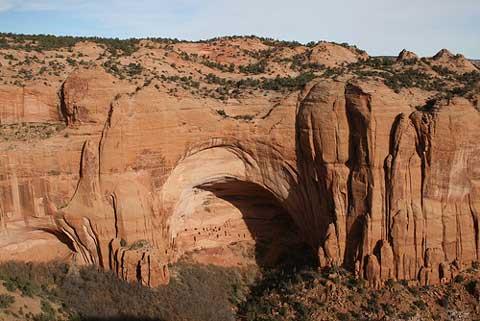Navajo National Monument includes great history, fine scenery and an off-the-beaten path location that allows you to escape the crowds. The park also includes an interesting wildlife species—a carnivorous mouse with a call said to resemble the howl of a wolf.
Originally established on March 20, 1909, the park celebrates the start of its second century today. The area contains three distinct and separate sections, all managed from a single headquarters. An administrative history of the site notes:
The three sections of the monument, Betatakin, Keet Seel, and Inscription House, are surrounded by the Navajo reservation. Ruins date from the 13th century and contain the best examples of the Kayenta Anasazi culture within the national park system. Yet because of their location and the distance between the three areas, Navajo National Monument is an inholding on the Navajo reservation.
This condition has created a level of interdependence unequaled elsewhere in the national park system. The monument and its neighbors depend on each other for mutual sustenance. The park provides a range of services not otherwise available as well as significant employment opportunities to the people of the Shonto region. Through a complex series of formal agreements and customs, local Navajos support the park and participate in its activities.
The main section, referred to by the name of the cliff dwelling it was established to protect, Betatakin, includes 160 acres of government land and a 244.59-acre section of land used under the terms of an agreement with the Navajo Nation. The Keet Seel section, about eight miles cross-country from Betatakin, contains one of the most important large Pueblo ruins in the Southwest within its 160-acre boundary. Inscription House, the third section and also named for its primary ruin, is forty miles away in Nitsin Canyon.
Navajo National Monument offers one of the great bargains in the country today. There's no entrance fee, no charge for camping, and ranger-conducted hikes are still free of charge.
The park includes two small campgrounds, one of which is open all year. Three trails near the visitor center offer fairly easy walks; two provide distant views of the Betatakin/Talastima cliff dwelling from an overlook.
Summer visitors who are ready for a strenuous 5-mile round trip can join a ranger on a daily hike to Betatakin. This trek begins at an elevation of 7,300 feet and loses and regains 700 feet along the way. It's a great hike, but pay attention to the park's cautions about those with health—or conditioning—issues!
Those who are looking for a more serious challenge may want to consider the hike to Keet Seel. This is a 17-mile round-trip hike on a primitive trail over sand hills and rocks, with numerous crossings of an ankle-deep stream. A backcountry permit is required for this hike, and with only twenty permits a day you won't have to fight crowds on the trail. During the warmer months, hikers may choose to make this a long day trip or stay overnight in the campground near Keet Seel.
There's plenty of scenery and some interesting natural history along with fine archaeology at this park.
The Colorado Plateau, the setting for the monument, has an unusual impact on people. It is haunting, for the region contains some of the most threatening and striking landscape in the U.S. Rugged and beautiful, its stark outlines and muted colors reflect the difficulty of human endeavor in this unforgiving region.
Among the wildlife found in the area is the grasshopper mouse, a rather atypical carnivorous rodent that "howls", or calls with a high-pitched whistle said to resemble a wolf or coyote. The park's location far from city lights also makes it a great place to appreciate the night sky—and you're now forewarned if your star-gazing is interrupted by some unusual howls.
This part of northern Arizona has long been important to several cultures.
Ancestors of the Hopi people who built these places are called Hisatsinom. Zuni, also pueblo builders, know that several of their clans began in this area. Later, the San Juan Southern Paiute, famous for their baskets, moved into this area and lived near the cliff dwellings. Today, this place is surrounded by the Navajo Nation, as it has been for hundreds of years.
During the summer, you can get a first-hand look at the work of a weaver, a silversmith, a painter, a sash weaver, and a basket maker, all of whom demonstrate their skills in the park's visitor center near the Betatakin Ruin section of the park.
The park website includes information on guided tours, operating hours and camping and a map to help with your navigation.
Plenty of tourists make the drive across the Navajo Nation between the Grand Canyon and the Four Corners region of the Southwest. Perhaps some of them even note the sign along U.S. 160 between Kayenta and Tuba City marking the turnoff to Navajo National Monument, but relatively few of them bother to stop. It's their loss.




Add comment